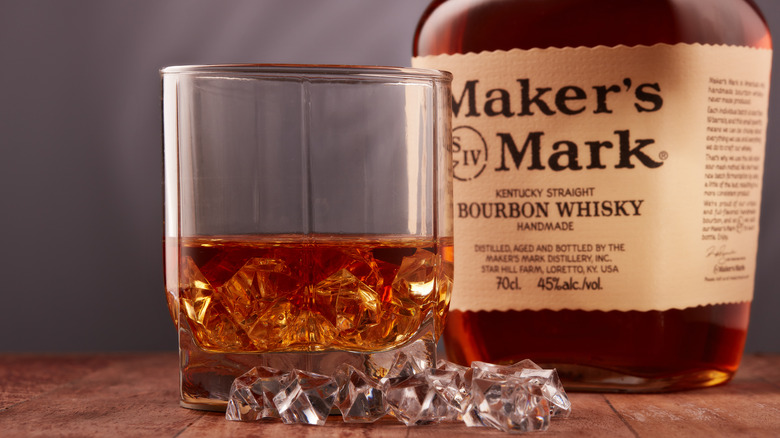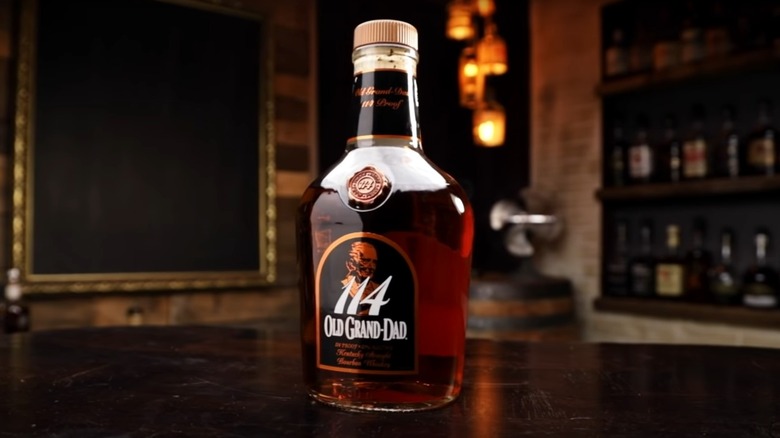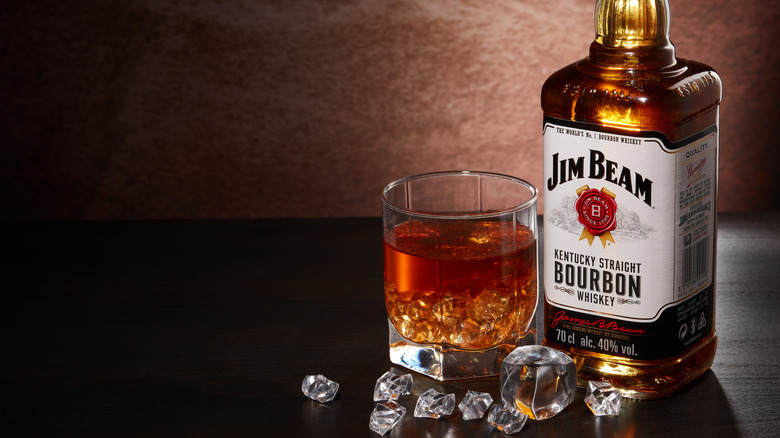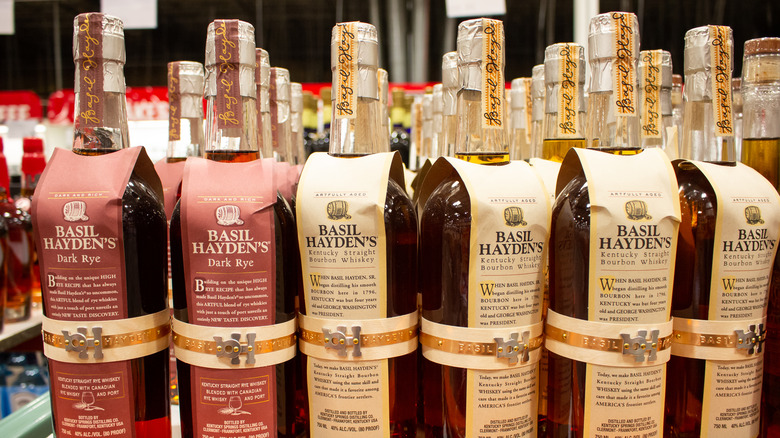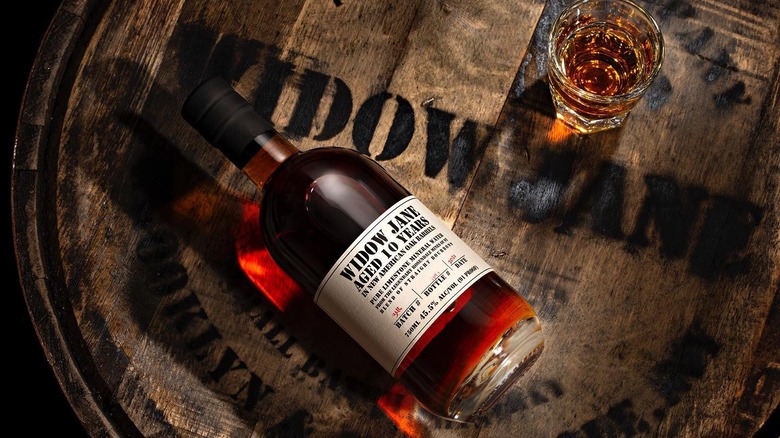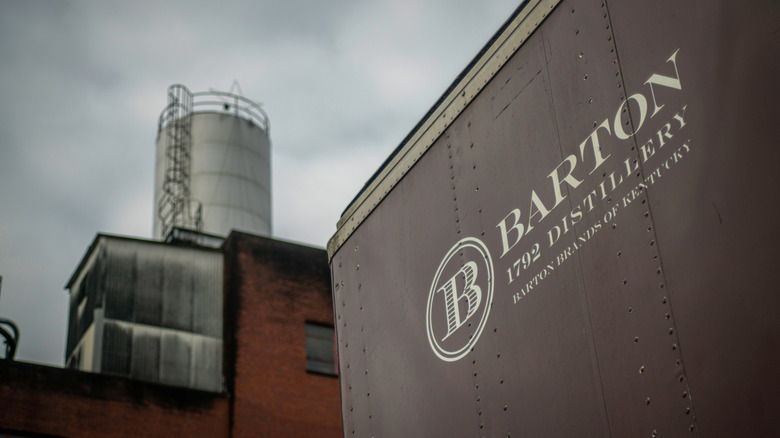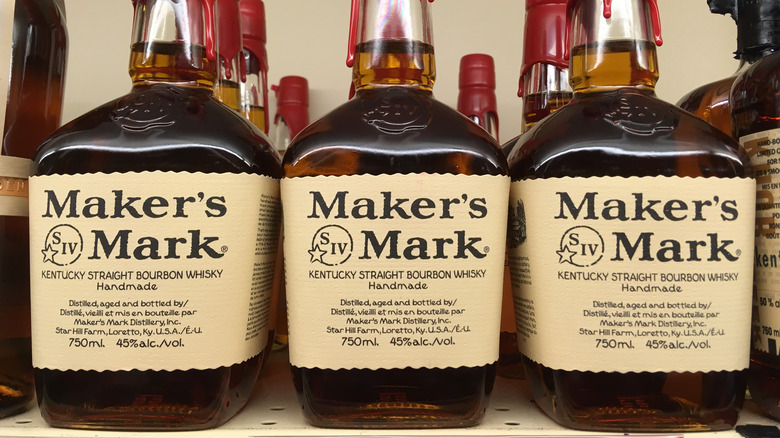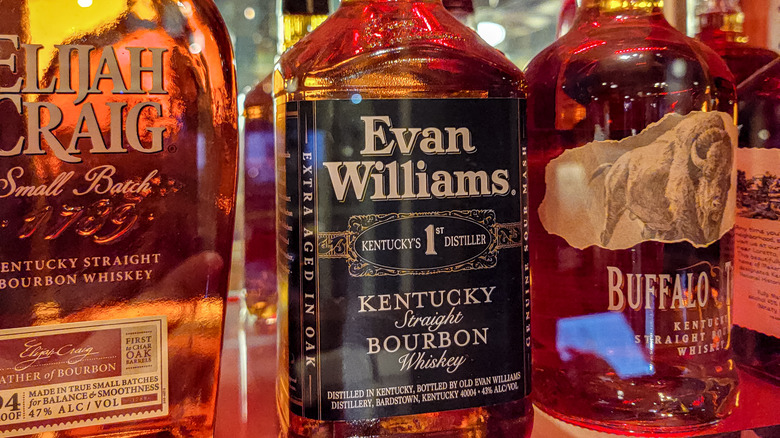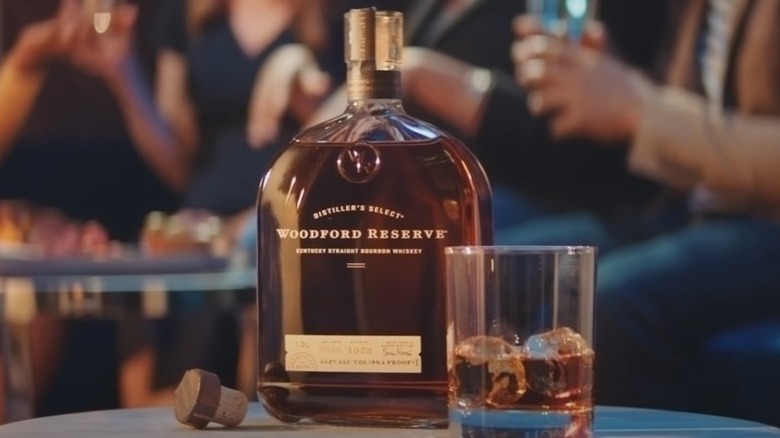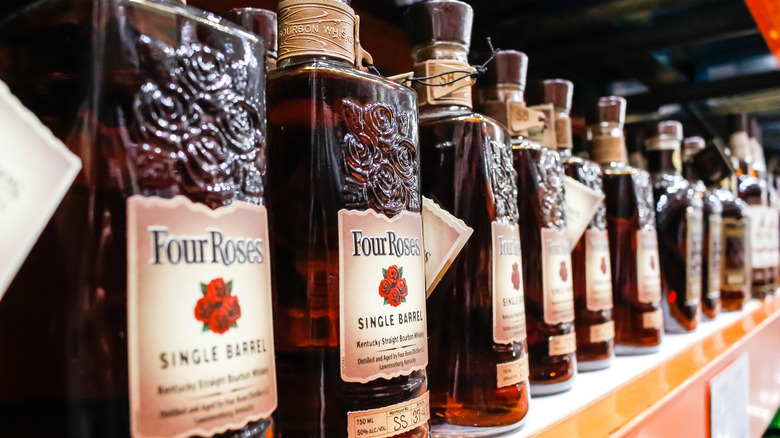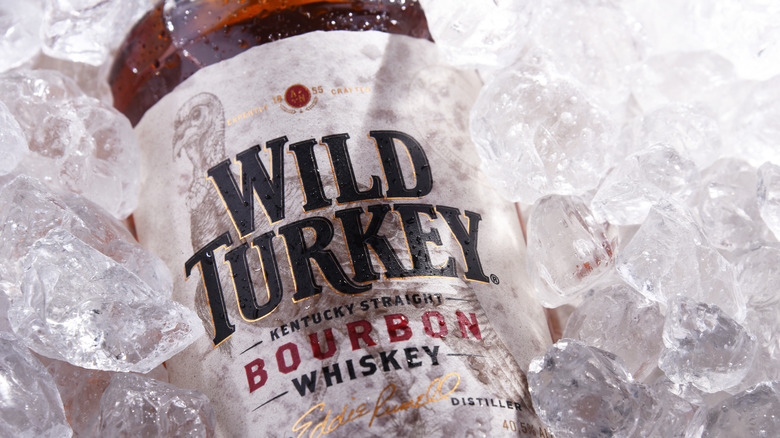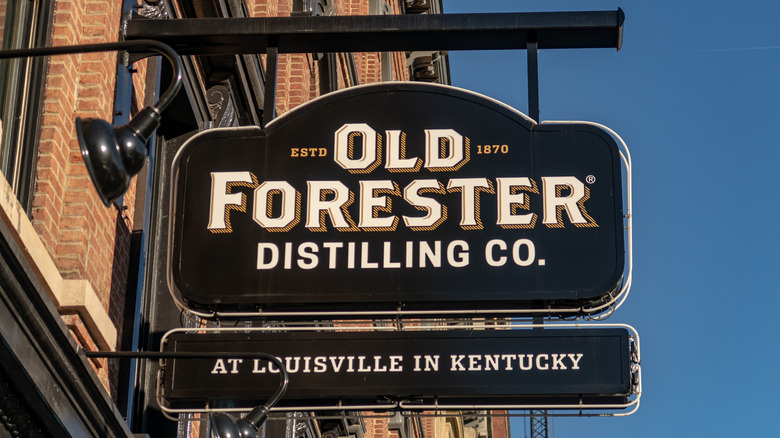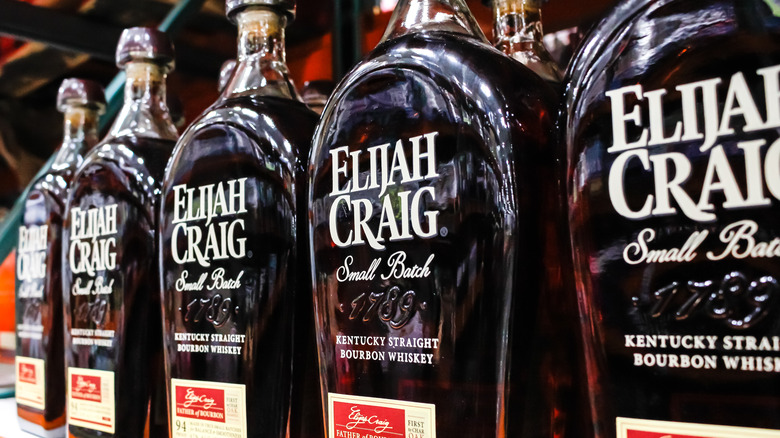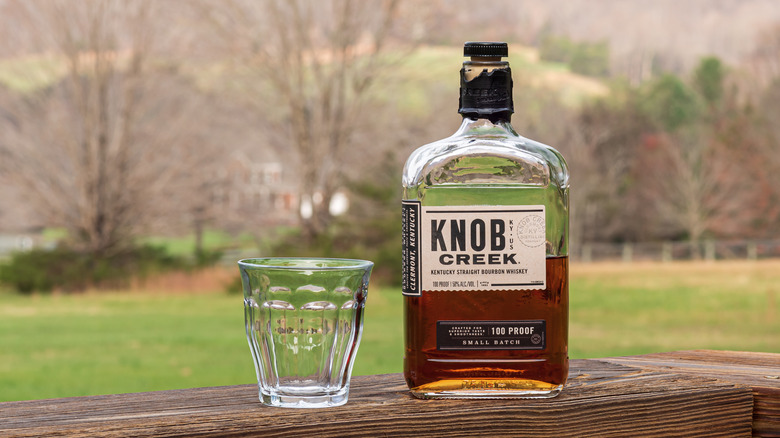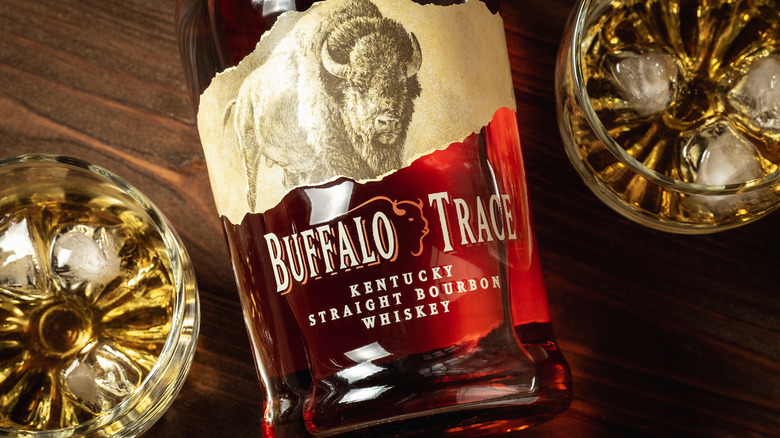Ranking The Big Bourbon Brands, From Worst To Best
No liquor speaks to American history, folklore, and tradition like bourbon. While whiskey can be made anywhere, bourbon can only be made in the United States, according to Distiller, and its mash bill (grain composition) must contain at least 51% corn, a grain native to the Americas. Officially defined as American-made corn-based whiskey aged in new charred oak barrels, bourbon first emerged in the 1780s in Kentucky, where settlers from Scotland and Ireland adapted their whiskey-making skills to local ingredients, as explained by The Spruce Eats.
Beyond these basics, the details of bourbon's history are murky. Was the technique of aging bourbon in charred oak barrels, the signature step responsible for bourbon's unique flavor, invented by Elijah Craig in 1789, the Tarascon brothers in 1807, or, more prosaically, the improvisation of numerous distillers who charred the interiors of used fish barrels to deodorize and sterilize them? The truth may be lost to time, but many of the original family-owned distilleries from the 1700s are still going strong, albeit under new corporate ownership in some cases. So if you've ever enjoyed bourbon from Maker's Mark or Jim Beam, know that you've experienced a taste of early American history. Clearly, such heritage brands have stood the test of time — here's how they fare in comparison with newer players in the bourbon game. But remember, taste is subjective, and at the end of the day, your rankings are the only ones that count.
14. Old Grand-Dad is just too intense and spicy
If your idea of a perfect bourbon is a smooth sipper, characterized by delicate aromas of nuts and fruit and gentle on the palate, Old Grand-Dad is most definitely not for you. Instead, this venerable budget brand (which you may have last seen in your grumpy great-uncle's pantry) is known for its unapologetic kick. Whoever Old Grand-Dad was, he didn't pull his punches. And while some bourbon fans love this rough-and-ready style (Lynyrd Skynyrd gave the brand a shout-out in on of their songs, as noted by Whiskey Reviewer), it's definitely not for everyone, which is why we're putting it low on our list. This doesn't mean it's necessarily terrible; it's just not to most drinkers' tastes.
So what makes Old Grand-Dad distinctive? The brand is characterized by an alcoholic burn and a strong hit of spice due to its rye-heavy mash bill. As Malt Review shared, it's "mouth-puckeringly tart at first" with an "iron-like stiffness from the beginning to the end of the mouth" and "the spiciness of Big Red chewing gum." In short, if Old Grand-Dad had a life philosophy, it was probably "go big or go home."
13. Jim Beam is a straightforward, affordable tipple
Jim Beam is not only one of the biggest-selling bourbon brands, but it is one of the oldest. The Beam (originally Boehm) family settled in Kentucky and began selling whiskey there in 1795, according to The Whiskey Reviewer. Today, the brand produces numerous expressions of bourbon, from its young, sweet Original Bourbon to its Green Label, Black Label, Rye, and other varieties. While one of the most familiar bourbon brands, Jim Beam is not known for its depth or subtlety. The Whiskey Reviewer described its Original Bourbon as having a nose "like a thin, sweet vanilla syrup" and a finish that's "sweet, but not especially long or deep." Its Black Label Bourbon is a bit more nuanced, with "flavors of caramel, oak, and very light charcoal," according to a separate review on The Whiskey Reviewer.
Jim Beam may not be practicing the world's most ambitious blending and distilling, but for a brand to have lasted over 200 years, it must be doing something right. And that something is offering up decent bottles at affordable prices. As The Whiskey Reviewer noted, the Black Bourbon, in particular, "would be appropriate for an inexpensive go-to, for cocktails or mixers."
12. Basil Hayden's is Old Grand-Dad's fancier cousin
A popular marketing strategy is for companies to offer product lines and brands at different price points. Superstar chef Wolfgang Puck offers both fine dining at his flagship Beverly Hills restaurant and frozen supermarket pizzas for the masses, and some chic designers offer both bespoke runway pieces and fast fashion at Target. Bourbon makers can play this game too, producing both unpretentious mass-market bottles and more refined, smaller-batch expressions.
Basil Hayden's is such a case. Named for a prominent 18th century distiller (the same one pictured on the label of Old Grand-Dad, according to Malt Review), Basil Hayden's is produced in the same production distillery as Old Grand-Dad and Jim Beam, according to 31 Whiskey. And the similarities don't end there — Basil Hayden's even boasts the same rye-forward malt bill as Old Grand-Dad. As 31 Whiskey noted, "Basil Hayden's is to Old Grand-Dad as Acura is to Honda." And the family resemblance is clear, although Basil Hayden's is smoother, with flavors of oak and nutmeg balancing out the peppery notes from the rye. In short, as 31 Whiskey stated, "It really does feel like they took a little bit more care with a couple barrels of Old Grand-Dad, dressed it up in a prettier bottle ... and charged twice as much for the privilege." Whether or not this is worth your while depends on your fondness for Old Grand-Dad.
11. Widow Jane is a newcomer worth noticing
No, Widow Jane is not Basil Hayden's elderly aunt. Rather, Brooklyn, New-York-based Widow Jane is a relative newcomer to the bourbon scene. Founded in 2012, the brand is so young the bourbons it produces in its own distillery in upstate New York are not yet sufficiently aged for consumption, according to 31 Whiskey. Rather, Widow Jane currently sources its bourbons from several undisclosed distilleries in Kentucky, Tennessee, and Indiana, then barrel-ages and blends them — which is how a nine-year-old company has been able to sell 10-year-old bourbon since its inception.
Widow Jane's claim to fame — and major marketing boast — is that its bourbon blends are finished with limestone-filtered water from the nearby Widow Jane mine. This claim, however, has been disputed by the Century House Historical Society, the current custodians of the mine and surrounding properties, as Blue Stone Press reported. In any case, Widow Jane is finished with fresh water from... somewhere. This touch results in a tasty-enough prototypical bourbon that "has left so much on the table due to being diluted down," according to Whiskey Consensus. And while flavorful enough, it's not all that unique, and its high price point makes it a difficult choice to get behind. It'll be interesting to see how Widow Jane evolves once its own distilled products start to enter the picture.
10. Barton 1792 is a smooth sipper for traditionalists
Like many distilleries, Barton 1792 has a convoluted history. It was neither founded by anyone named Barton nor was it founded in 1792 (rather, that date refers to the year of Kentucky's statehood, according to Malt). It actually dates back to 1879, after which a series of ownership changes resulted in its current name and product line.
Despite whatever institutional turmoil it has endured, Barton 1792 produces low-key, understated expressions. And while not as well-known as reputable mid-range brands like Maker's Mark, it's still worth investigating. The Whiskey Reviewer described its 12-year-old bourbon as having a nose of "brown sugar, cinnamon graham crackers and vanilla, accented by toasty oak." The Whiskey Reviewer further noted that it doesn't offer those drinking it "any surprises," as "there are no twists or particularly subtle nuances." Malt described their Very Old Barton Bottled in Bond as having "a solid quality/price ratio" that would make it a potentially "reliable go-to or house bourbon" were it more readily available.
In short, Barton 1792 is nothing to write home about, but it offers solidly made bourbon that hits the right notes for those with traditional tastes.
9. Maker's Mark is a simple, dependable favorite
Maker's Mark is one of the best-known bourbon brands. If you have even a passing familiarity with bourbon, you'd probably recognize its distinctive square bottle and red wax-dipped cap from across the room. It's also known for its distinctive flavor, due to its unusual mash bill. Like all bourbon, its mash bill is mostly corn with a touch of malted barley. But unlike most other bourbon brands, Maker's Mark does not contain any rye, instead supplementing the corn with red winter wheat, according to The Spruce Eats.
This gives Maker's Mark a softer, richer flavor than rye-forward bourbons, with lots of caramel and fruit on the nose, and a pleasant hint of oak, according to Breaking Bourbon. It has a light mouthfeel and is less sweet than its aroma would suggest. It is, according to Breaking Bourbon, "a down-the-middle bourbon and will appeal to just about anyone." Its easygoing character gives Maker's Mark another advantage, according to The Spruce Eats; while not the most memorable tipple to enjoy neat, it's fabulous in cocktails.
8. Evan Williams offers exceptional refinement at a surprising price
Not many of us have the ducats to stock our bars with only top-of-the-line, limited-edition releases. Even serious bourbon connoisseurs know there's a time to break out the fancy stuff and a time when an affordable mass-market brand fits the bill quite nicely. And this is where brands like Evan Williams come in handy. While not as big a name as Jim Beam or Wild Turkey, it's a widely distributed brand that you can serve at a big party without breaking the bank, yet won't be ashamed to mix into a cocktail for that bourbon snob friend.
Named for an 18th-century Kentucky settler who was allegedly Kentucky's first distiller (an impossible claim to prove, according to The Whiskey Jug), Evan Williams in reality has no relationship to its namesake. Its producer, Heaven Hill Distillery, wasn't founded until 1935, according to Malt. But however spurious its suggested origin story, Evan Williams as a bourbon is the real deal. It's a balanced, austere bourbon, with a sophisticated nose that Malt described as "ferric, green and vegetal notes balanced against warm, very subtly woody vanilla." Compared to the familiar caramel-and-vanilla bombs, Evan Williams comes off as more restrained and lean, making it a good choice for those who usually find bourbon too sweet.
7. Woodford Reserve inspired the premium bourbon trend
Woodford Reserve is a modern bourbon brand with deep roots — per Breaking Bourbon, it's produced and bottled in a distillery dating back to 1780. It was intended from the start to be a premium brand — a radical idea at the time when bourbon was seen as a working person's drink. But it successfully managed to earn both public acceptance and respect, even becoming the official bourbon of the Kentucky Derby.
Woodford Reserve may have done almost too good a job at making premium bourbon acceptable — today, with hundreds of craft distillers creating their own premium blends, Woodford Reserve now falls near the middle of the curve in terms of price and status. Critical consensus seems to put it in the middle of the curve as well — not a terrible place to be at a time when even budget brands are turning out good-quality products. The Whiskey Shelf noted that it "has some of the quintessential bourbon flavors, but overall there's not a lot going on," and Breaking Bourbon said its "straightforward and approachable flavor profile" makes it a "good base for cocktails."
So, Woodford Reserve is near the middle of our list not because it's mediocre, but because it's solidly respectable — it delivers exactly what you'd expect from a mid-range bourbon, no more and no less.
6. Four Roses is a popular mid-price choice
Dating back to the 1880s, Four Roses boasts both an unusual history and an unusual way of making its bourbons. Despite its roots in Kentucky, Four Roses was not sold in the United States for some time, but instead became popular in Europe and Asia, according to The Spruce Eats. And while blended whiskies are fairly common, Four Roses is unusual in that almost all of its expressions are blends: the distillery "uses five proprietary yeast strains and two separate mashbills to develop 10 whiskey recipes." These are rarely sold as is, but are rather aged for five to 10 years and blended in different combinations for each expression. And there are a lot of expressions, from their flagship 80-proof bourbon to their small-batch, single-barrel, and limited releases, offering bourbon geeks numerous options to collect and explore.
So how are they? 31 Whiskey called their middle-shelf Small Batch Kentucky Straight Bourbon Whiskey "a smooth and delicious bourbon" with a balanced mouthfeel and finish. On the other hand, Malt gave low marks to their pricey ($85) Single Barrel 73-IV, noting its "awkward and unbalanced sensations." But Whiskey Wash called their Yellow Label expression "the little black dress of bourbon...appropriate for everything." This suggests their tried-and-true middle-shelf expressions may be a safer bet for most tastes than their limited-edition experiments. Still, Four Roses deserves points for not being afraid to be different.
5. Don't laugh — Wild Turkey is better than you think
When you think of Wild Turkey, do you picture an unshaven guy sitting by himself in a bar, muttering at the TV and nursing a tumbler of the stuff before shuffling off to a depressing studio apartment somewhere? Well, think again — this venerable bottom-shelf brand deserves a lot more respect than it's been getting. According to 31 Whiskey, the brand has its origins in the 1940s, when a liquor wholesaler picked up a bottle of nameless bourbon from a distillery he dealt with and took it to share on a turkey hunt. His friends loved it and kept begging him for more "wild turkey bourbon" — and the rest is history.
So how does it taste? Its flagship product, Wild Turkey 101, is a classic bourbon expression, with a typical mash bill of corn, rye, and malted barley. Per Breaking Bourbon, it features the expected caramel, toffee, and vanilla notes on the nose, followed by a hit of spice, oak, and butterscotch. On the palate, its candied notes are balanced by oak, char, and spice. It has a spicy, peppery finish with some heat. It could be smoother and its hotness may strike some as excessive — but it offers remarkable quality for a budget tipple, which is why it deserves a position in our top five bourbons.
4. Old Forester is known for its rich, fruity nose
Numerous bourbon brands trace their roots to the 1800s or earlier. But Old Forester, which got its start in 1870, is unusual in that it's stayed in the hands of a single family since its founder, a pharmaceutical salesman, decided to dive into distilling, according to Malt. The family's unusual longevity as owners is presumably due in part to its roots in pharmaceuticals, which enabled them to pivot to medicinal alcohol during Prohibition, keeping the distillery alive until better times returned.
Today, many of Old Forester's expressions are formulated and marketed to evoke the brand's long history. Old Forester 1910 memorializes a fortuitous accident: In 1910, a fire on a bottling line forced the distillery to store the bourbon it had planned to bottle in a barrel. This delayed batch proved to have a winning flavor, which the current distillers reproduced via a secondary six-to-nine-month maturation in heavily charred barrels. But don't think of these unusual expressions as mere gimmicks — Whiskey Reviewer gave Old Forester's 150th Anniversary Bourbon a grade of A for its intensely fruity nose, reminiscent of cherries and bananas, as well as a lush mouthfeel. Malt likewise found pleasantly fruity notes in its Old Forester 1910.
3. Elijah Craig is a critics' favorite
Like Evan Williams, Elijah Craig is a Heaven Hill distillery brand named for a legendary figure in bourbon history. According to Breaking Bourbon, the original Elijah Craig was a Baptist preacher and said to be the inventor of the process of aging bourbon in charred oak barrels. Whether or not Craig actually did invent this process is up for debate, but what's not up for debate are the numerous awards given to the bourbon brand that shares his name. Elijah Craig's Barrel Proof expressions are regularly in the running for best bottle of the year, according to The Bourbon Bard. Their Barrel Proof Bourbon was named Whiskey of the Year by Whisky Advocate in 2017. Their Small Batch Bourbon took double gold in the San Francisco World Spirits Competition in 2018 and was named Best Small Batch at the same competition.
What makes Elijah Craig a critical favorite is its complexity and balance. As The Bourbon Bard noted, "It's versatile with the fruit notes lending themselves to summer drinking and the spice coming through for colder winter nights." Making a drink summery and wintery and pleasant to drink at the same time sounds like a fool's errand — but Elijah Craig seems to have figured it out.
2. Knob Creek is the ideal for bourbon
Bourbon can take a number of forms with vastly different personalities, but most critics and casual tasters agree that no matter what the brand or expression, a good bourbon should have a few fundamental characteristics: A caramel sweetness, a distinct taste of oak in the background, a flavor that matches and complements its initial aroma while balancing out the potentially overwhelming burn from the alcohol, and a pleasant mouthfeel and finish.
Knob Creek offers all of these, making it a model for what well-balanced bourbon is supposed to taste like. As noted by The Whiskey Wash, their flagship expression, Knob Creek Kentucky Straight Bourbon, offers vanilla and spice on the nose and palate without being overly sweet or cloying. The hint of oak connects and balances the flavors of fruit and spice. And despite its eyebrow-raising alcohol content (100 proof, or 50% ABV), it feels warm on the tongue, not abrasively hot. And according to Breaking Bourbon, the even higher-proof (120 proof) Knob Creek Single Barrel Bourbon "is really easy to love," offering a similarly well-balanced profile, smooth with a long-lasting complex finish of cinnamon, oak, and leather. Breaking Bourbon further noted that its smoothness, sweetness, and complexity make it easy and enjoyable to drink for both experienced and novice bourbon tasters. Its balance and wide appeal are what puts Knob Creek near the top of our list.
1. Buffalo Trace does indeed live up to its hype
Buffalo Trace is like that brilliant, beautiful, and disgustingly successful girl from school that you wanted to hate — but just couldn't because she was so very nice. Which only made you want to hate her more.
Buffalo Trace earned a reputation as a brand that turns casual drinkers into serious bourbon fans. The Bourbon Bard lauds it as "the bourbon that made me love the actual taste of bourbon," and Breaking Bourbon called it "instantly likeable and pleasant with notes of caramel, honey, orange, and vanilla" with a nose revealing "an underlying layer of oak and mint." In other words, it's easy to drink with all the expected bourbon flavors and aromas, with plenty of depth for serious sippers to appreciate.
But while easy to love, Buffalo Trace isn't always easy to find. This is because of its popularity; the brand simply can't make enough of the stuff to satisfy its thirsty fans. To mitigate this problem, Buffalo Trace implemented a distribution system that allocated a fixed number of bottles yearly to each state, according to Gear Patrol. This system was intended to make things fairer for consumers, but in some areas, there was the opposite effect, with fans crossing state lines in search of a bottle, according to The Bourbon Bard. Hence the hate. Still, any bourbon worth a day's drive is worth noticing — and worth the top honor on our list.
